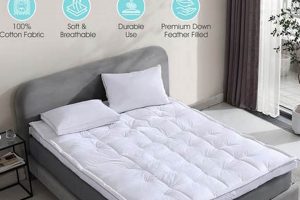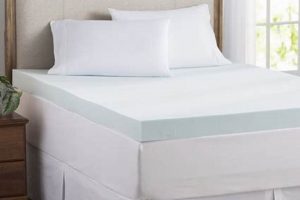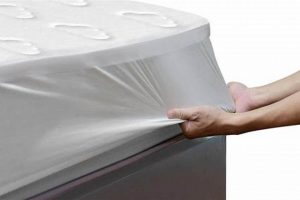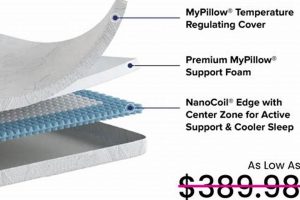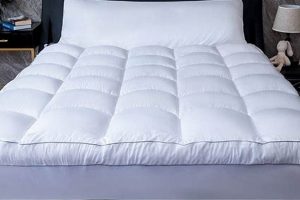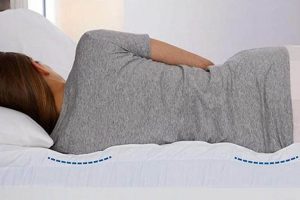This type of bed accessory is characterized by a convoluted surface resembling an egg carton. Typically constructed from foam, it is placed atop a mattress to modify its feel. The undulating design creates peaks and valleys across the surface. These differing heights provide varied levels of support and compression when weight is applied.
The primary function of this bedding component is to enhance comfort and potentially alleviate pressure points. The unique structure is intended to promote air circulation, which can contribute to temperature regulation during sleep. Historically, it has been utilized in healthcare settings and residential environments to improve the sleeping experience.
The subsequent sections will delve into the material composition, density options, cleaning procedures, and lifespan expectations associated with these textured mattress additions. Further discussion will explore the varying firmness levels available and the suitability of each for different sleep positions and body types.
Optimizing Use
This section outlines key considerations for maximizing the benefits and longevity of a convoluted foam mattress overlay. Adhering to these guidelines ensures both comfort and proper maintenance.
Tip 1: Density Selection. Higher density foam provides greater support and durability. Individuals seeking substantial pressure relief should consider a density of at least 3 pounds per cubic foot.
Tip 2: Regular Rotation. To promote even wear and prevent indentations, rotate the topper 180 degrees every three months. This distributes weight and pressure across the entire surface.
Tip 3: Protective Covering. Employ a fitted sheet or mattress protector to shield the foam from spills, stains, and dust mites. This extends the topper’s lifespan and maintains hygiene.
Tip 4: Proper Cleaning. Avoid machine washing or drying. Spot clean with a mild detergent and allow to air dry completely. Thorough drying prevents mildew growth.
Tip 5: Ventilation. Periodically remove bedding and allow the topper to air out. This improves ventilation and reduces moisture buildup, contributing to a fresher sleeping environment.
Tip 6: Assess Mattress Compatibility. Ensure the underlying mattress provides adequate support. A topper cannot compensate for a severely sagging or worn-out mattress.
Tip 7: Monitor for Degradation. Inspect regularly for signs of crumbling, yellowing, or loss of support. Replace when significant degradation occurs to maintain optimal comfort and hygiene.
By implementing these measures, individuals can maximize the comfort, support, and longevity of this type of mattress addition. Prioritizing proper care and maintenance ensures a consistent and hygienic sleep surface.
The concluding section will summarize the key features and benefits and offer a final perspective on whether this type of mattress topper meets individual sleep needs.
1. Pressure Point Relief
The convoluted design inherent to a mattress topper creates a surface that conforms more readily to the body’s contours compared to a flat, uniform surface. This increased conformity directly contributes to pressure redistribution. Instead of concentrated pressure at specific contact points like shoulders and hips, weight is dispersed across a wider area. For example, a side sleeper may experience reduced pressure on their hip joint due to the conforming nature of the topper, minimizing discomfort that can disrupt sleep.
The effectiveness in alleviating pressure is contingent on foam density and thickness. Higher density foams offer more support and prevent excessive compression, maintaining the contour’s structure for consistent pressure relief. Inadequate density may result in the individual sinking through the topper, negating its intended effect. Furthermore, the undulating surface promotes air circulation, mitigating heat buildup that can exacerbate pressure-related discomfort. The practical significance lies in the potential for improved sleep quality, particularly for individuals with arthritis, fibromyalgia, or other conditions characterized by heightened sensitivity to pressure.
Proper selection and maintenance are paramount to realizing pressure relief benefits. Evaluating foam density in relation to body weight and preferred sleep position is crucial. Regular rotation and protection from moisture and compression ensure the longevity of the topper and sustained performance. While the topper is not a substitute for medical treatment, it represents a cost-effective intervention for managing pressure-related discomfort and enhancing sleep comfort.
2. Air Circulation Design
The defining characteristic of a convoluted foam mattress overlay is its undulating surface, forming a series of peaks and valleys. This structure directly contributes to enhanced air circulation compared to a flat foam surface. The channels created by the valleys allow for greater airflow around the sleeper’s body. This is significant because body heat, when trapped against the mattress, can lead to discomfort and disrupted sleep. In cases of individuals experiencing night sweats, this feature becomes particularly beneficial. The increased airflow facilitates the evaporation of moisture, thereby helping to regulate body temperature and promoting a more comfortable sleep environment.
The degree of air circulation effectiveness depends on several factors, including the depth and width of the channels, the foam density, and the type of bedding used. Deeper and wider channels provide greater airflow. Denser foams, while offering more support, may slightly impede airflow compared to less dense foams. Heavy bedding or non-breathable mattress protectors can negate the benefits of the air circulation design. As an example, using a breathable cotton sheet atop the topper will allow for optimal airflow, while a polyester sheet may restrict it. The intended outcome of improved airflow is not only temperature regulation but also a reduction in the growth of mold and mildew, contributing to a healthier sleep surface.
Understanding the air circulation design’s function within the framework of a convoluted mattress topper enables informed consumer choices. Individuals prone to overheating during sleep or residing in warmer climates may find significant value in this feature. However, awareness of factors that can diminish the effectiveness of the design, such as bedding choices, is crucial. While the convoluted surface inherently promotes airflow, optimal performance is achieved through careful consideration of complementary factors and consistent maintenance. The benefit of improved air circulation is one of the primary factors considered when evaluating the overall suitability of this bedding accessory.
3. Foam Density Options
Foam density, measured in pounds per cubic foot (lbs/ft), represents a critical determinant of the performance and longevity of a convoluted foam mattress overlay. It directly influences support, durability, and overall user experience. Selecting an appropriate density is essential to realize the intended benefits of this bedding accessory.
- Low-Density Foam (Under 2 lbs/ft)
Low-density foam offers minimal support and exhibits a shorter lifespan. While less expensive, it tends to compress rapidly, reducing its ability to relieve pressure points effectively. For instance, a low-density topper may initially feel comfortable but quickly flatten under body weight, diminishing its therapeutic value. These are generally not recommended for regular use.
- Medium-Density Foam (2-3 lbs/ft)
Medium-density foam strikes a balance between comfort and support. It offers adequate pressure relief for individuals of average weight and can withstand moderate use. An example is a topper used in a guest bedroom, where it may not be subjected to daily wear. This density range provides a reasonable compromise between cost and performance.
- High-Density Foam (Over 3 lbs/ft)
High-density foam delivers superior support and durability. It resists compression and maintains its shape over extended periods. Individuals seeking substantial pressure relief, particularly those with higher body weights or specific medical conditions, benefit most from this density. For example, a high-density topper can provide consistent support for side sleepers, preventing excessive pressure on the hip and shoulder joints.
- Impact on Convoluted Design
The foam density interacts directly with the convoluted design. Low-density foam in a convoluted shape will compress more easily, reducing the effectiveness of the peaks and valleys in promoting air circulation and pressure distribution. Conversely, higher density foam maintains the structural integrity of the design, ensuring consistent airflow and targeted support. The intended benefits are optimized when the density complements the inherent properties of the convoluted pattern.
Ultimately, the optimal foam density depends on individual needs and preferences. Considerations include body weight, sleep position, budget, and desired level of support. Careful evaluation of these factors, in conjunction with an understanding of density characteristics, enables informed selection and maximization of the benefits associated with a convoluted foam mattress overlay.
4. Thickness Variability
The thickness of a convoluted foam mattress overlay directly influences its performance characteristics, particularly in relation to pressure relief and support. Thickness variability, often ranging from one to four inches, dictates the degree of cushioning and contouring provided. A thinner overlay offers subtle alterations to the existing mattress feel, providing minimal pressure relief. Conversely, a thicker variant significantly alters the sleep surface, offering enhanced cushioning and greater pressure redistribution. For example, an individual with a firm mattress may select a thicker overlay to soften the surface and alleviate pressure on sensitive joints. The depth of the convolutions also factors into perceived thickness and overall comfort. Shallower convolutions provide a firmer feel, while deeper convolutions offer more pronounced cushioning and enhanced airflow. Selecting an appropriate thickness is crucial to achieving the desired balance between comfort and support.
Practical applications of varying thicknesses are evident in diverse sleeping arrangements. Individuals seeking minor enhancements to an already comfortable mattress may opt for a thinner profile to preserve the existing support characteristics while adding a layer of conforming comfort. In contrast, those attempting to mitigate the effects of an overly firm or aging mattress often choose a thicker overlay to provide substantial cushioning and compensate for diminished support. Healthcare settings frequently utilize thicker overlays to reduce the risk of pressure sores in bedridden patients. The choice of thickness also impacts the overall height of the bed, a consideration for individuals with mobility limitations. A thicker overlay adds several inches, potentially making it more difficult to get into and out of bed.
In summary, thickness variability represents a key parameter influencing the performance of a convoluted foam mattress overlay. The selection of an appropriate thickness should be guided by individual preferences, the characteristics of the underlying mattress, and specific comfort or support requirements. While a thicker overlay generally offers greater cushioning and pressure relief, it also impacts bed height and may alter the overall feel of the sleep surface more significantly. Understanding the relationship between thickness and performance is essential for maximizing the benefits and ensuring satisfaction with this bedding accessory. Ignoring this factor could result in inadequate support or excessive sinkage, negating the intended advantages of the overlay.
5. Lifespan Expectation
The lifespan of a convoluted foam mattress overlay is inherently linked to its material composition, density, usage patterns, and care. Lower-density foams, common in budget-friendly options, exhibit a shorter lifespan due to their susceptibility to compression and degradation. For example, a topper made from low-density polyurethane foam may only retain its supportive qualities for one to two years under regular use. Conversely, higher-density memory foam or latex variants generally offer extended durability, potentially lasting five years or more with proper maintenance. The severity of use, including factors such as body weight and sleeping position, significantly influences the rate of wear. Individuals with higher body weights, or those who consistently sleep in the same position, will likely experience accelerated compression of the foam.
Maintenance practices play a crucial role in maximizing the longevity of these mattress additions. Regular rotation helps to distribute wear evenly across the surface, preventing localized compression. Protecting the topper with a mattress protector or fitted sheet shields it from spills, stains, and dust mites, which can compromise the foam’s integrity. Periodic cleaning, using gentle detergents and avoiding harsh chemicals or excessive moisture, prevents degradation and maintains hygiene. Failure to adhere to these maintenance guidelines can significantly shorten the lifespan, leading to premature replacement. Consider a scenario where a spill occurs and is not promptly cleaned; the liquid can penetrate the foam, fostering mold growth and accelerating the breakdown of the material.
In conclusion, lifespan expectation is a critical factor to consider when evaluating a convoluted foam mattress overlay. Selecting a higher-density foam and implementing appropriate maintenance practices can extend the product’s usable life, representing a more sustainable and cost-effective solution in the long term. Understanding the interplay between material properties, usage patterns, and ca
re enables informed purchasing decisions and maximizes the return on investment. While budget constraints may influence initial choices, prioritizing durability can mitigate the need for frequent replacements and contribute to a more comfortable and supportive sleep environment over time.
Frequently Asked Questions
The following addresses commonly encountered questions regarding convoluted foam mattress overlays, providing factual information to aid in informed decision-making.
Question 1: What distinguishes a convoluted foam mattress overlay from a memory foam topper?
Convoluted foam overlays possess a distinct undulating surface, designed to promote air circulation and distribute pressure. Memory foam toppers, conversely, typically feature a uniform, flat surface and conform to the body through viscoelastic properties.
Question 2: How does the density of a convoluted foam overlay impact its performance?
Density directly correlates with support and durability. Higher-density foams resist compression and provide greater pressure relief over extended periods, while lower-density foams offer minimal support and degrade more rapidly.
Question 3: Can a convoluted foam mattress overlay correct a severely sagging mattress?
A convoluted foam overlay provides supplemental support and cushioning but cannot rectify significant structural deficiencies in an underlying mattress. A severely sagging mattress necessitates replacement.
Question 4: What is the recommended cleaning procedure for a convoluted foam mattress overlay?
Spot cleaning with a mild detergent and allowing to air dry completely is recommended. Machine washing or drying can damage the foam’s structure and is generally discouraged.
Question 5: How frequently should a convoluted foam mattress overlay be replaced?
The lifespan is contingent on foam density, usage, and maintenance. Signs of degradation, such as crumbling, yellowing, or loss of support, indicate the need for replacement. Generally, they will need to be replaced every 1-5 years depending on the quality and usage.
Question 6: Are convoluted foam mattress overlays suitable for individuals with allergies?
While the design may promote airflow and reduce moisture buildup, the foam itself can harbor allergens. Employing a hypoallergenic mattress protector is recommended to mitigate this risk.
In summation, understanding the characteristics, limitations, and maintenance requirements associated with convoluted foam mattress overlays enables informed selection and utilization.
The succeeding section will present a comparative analysis against alternative mattress enhancement products.
Egg Crate Mattress Topper
This exploration of the egg crate mattress topper has revealed a multifaceted product with potential benefits and limitations. The contoured design offers pressure redistribution and enhanced air circulation, while foam density and thickness dictate support and longevity. Proper maintenance and informed selection are essential to maximizing its utility. As demonstrated, the selection of an appropriate topper is influenced by individual needs, pre-existing bed conditions, and other important factors.
The utility of the egg crate mattress topper rests on a clear understanding of its attributes and responsible implementation. Should the conditions previously described be met and the selection process be carefully considered, the topper has the capacity to improve sleep and increase comfort. This information should assist consumers in making informed decisions, ensuring that this bedding choice aligns with specific requirements and expectations. Future studies could determine if the benefits found here are seen across wide populations.


